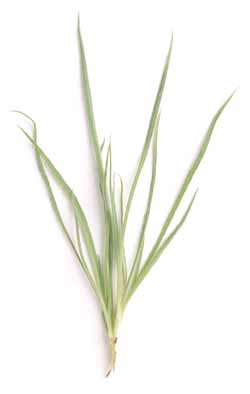Indian Psyllium Seeds
Sow 1/4" deep, space seeds a few inches apart. Later thin to about a foot apart in rows 24" apart. Does well in any garden soil, sow seeds after last frost in early spring.

Plantago ovata
A low growing annual with soft, grass like, hairy leaves. The famous Metamucil laxative is made from the seeds. Used in remedies for constipation and bowel problems.
Mucilaginous seed coats, lubricate and cleanse the intestines, also acting as a mild laxative.
Seed has property of mucilage formation on extraction of moisture.
Psyllium seeds are cooling, laxative, soothing, antiacidic, anti diuretic and demulcent.
Grows well in almost any garden soil.
Industrially used as basic stabilizer in ice-cream, sizing in chocolate, seed mucilage are also used in cosmetics.
[4]Grieve. A Modern Herbal. Not so modern (1930's?) but lots of information, mainly temperate plants. [9]Launert. E. Edible and Medicinal Plants.
Covers plants in Europe. a drawing of each plant, quite a bit of interesting information. [46]Uphof. J. C. Th. Dictionary of Economic Plants. An excellent and very comprehensive guide but it only gives very short descriptions of the uses without any details of how to utilize the plants. Not for the casual reader.
[50]? Flora Europaea An immense work in 6 volumes (including the index). The standard reference flora for europe, it is very terse though and with very little extra information. Not for the casual reader. [61]Usher. G. A Dictionary of Plants Used by Man. Forget the sexist title, this is one of the best books on the subject. Lists a very extensive range of useful plants from around the world with very brief details of the uses. Not for the casual reader.
[105]Tanaka. T. Tanaka's Cyclopaedia of Edible Plants of the World. The most comprehensive guide to edible plants I've come across. Only the briefest entry for each species, though, and some of the entries are more than a little dubious. Not for the casual reader.
[165]Mills. S. Y. The Dictionary of Modern Herbalism. An excellent small herbal.
[171]Hill. A. F. Economic Botany. Not very comprehensive, but it is quite readable and goes into some a bit of detail about the plants it does cover.
[177]Kunkel. G. Plants for Human Consumption. An excellent book for the dedicated. A comprehensive listing of latin names with a brief list of edible parts.
[183]Facciola. S. Cornucopia - A Source Book of Edible Plants. Excellent. Contains a very wide range of conventional and unconventional food plants (including tropical) and where they can be obtained (mainly N. American nurseries but also research institutes and a lot of other nurseries from around the world. [200]Huxley. A. The New RHS Dictionary of Gardening. 1992. Excellent and very comprehensive, though it contains a number of silly mistakes. Readable yet also very detailed.
[240]Chopra. R. N., Nayar. S. L. and Chopra. I. C. Glossary of Indian Medicinal Plants (Including the Supplement).
Very terse details of medicinal uses of plants with a wide range of references and details of research into the plants chemistry. Not for the casual reader.
[254]Chevallier. A. The Encyclopedia of Medicinal Plants An excellent guide to over 500 of the more well known medicinal herbs from around the world.

